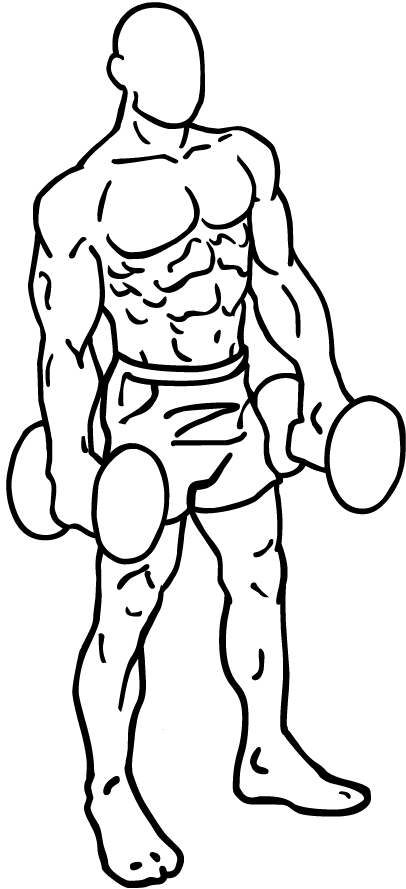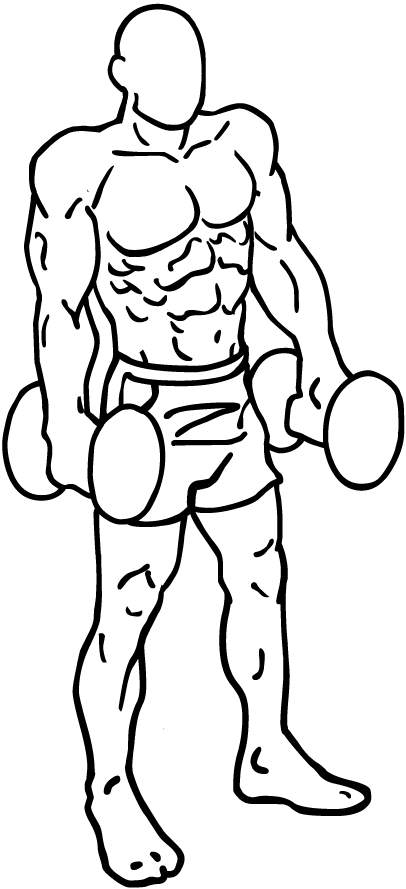Last Updated on September 26, 2014
Shoulder shrugs may seem simple, but they’re incredibly effective for building strength and stability in the trapezius muscles. This exercise, often overlooked in workout routines, plays a vital role in upper-body strength and posture. Whether you’re an athlete, bodybuilder, or someone looking to improve shoulder support and posture, shoulder shrugs can be a valuable addition to your routine. In this guide, we’ll explore everything you need to know about shoulder shrugs: from step-by-step instructions and form tips to advanced variations, benefits, common mistakes, and more.
What Are the Benefits of Shoulder Shrugs?
- Strengthens the Trapezius: Shoulder shrugs primarily target the upper trapezius, helping build strong, defined traps.
- Improves Shoulder Stability: Strong traps contribute to shoulder stability, benefiting pressing exercises like bench presses, overhead presses, and daily activities.
- Enhances Posture: Working on your traps helps pull the shoulders back and improve posture, especially for those who spend long hours at a desk.
- Reduces Risk of Shoulder Injuries: Strengthening the trapezius reduces stress on the rotator cuff and stabilizes the shoulder joint, minimizing injury risk.
- Functional Strength: Shrugs mimic natural shoulder movements, making them beneficial for sports and physical activities that require shoulder and neck strength.
Muscles Worked During Shoulder Shrugs
- Trapezius: The upper trapezius is the primary muscle engaged during shoulder shrugs, responsible for lifting the shoulders and stabilizing the neck and upper back.
- Levator Scapulae: Located at the back of the neck, this muscle assists in lifting the scapula (shoulder blade).
- Rhomboids and Deltoids: Secondary muscles like the rhomboids and rear deltoids are engaged to stabilize the shoulders.
- Core Stabilizers: Although not directly targeted, the core muscles support stability, especially when using heavy weights.
Step-by-Step Guide: How to Perform Shoulder Shrugs Correctly
- Set Up: Stand with your feet shoulder-width apart, knees slightly bent, and hold a dumbbell in each hand with your arms relaxed at your sides. Make sure to stand tall with your chest up and shoulders back.
- Engage Your Core: Brace your core and keep your spine straight. Look forward with a neutral neck position.
- Lower Your Shoulders: Start by lowering your shoulders fully, feeling a slight stretch in the trapezius.
- Shrug Upwards: Raise your shoulders towards your ears in a slow, controlled motion, squeezing the traps at the top. Keep your arms straight, focusing on lifting with the shoulders rather than pulling with your hands.
- Hold the Contraction: At the top of the movement, hold the position for a moment to maximize muscle engagement.
- Lower Back Down: Slowly lower your shoulders back to the starting position, allowing the traps to stretch slightly.
- Repeat for Desired Reps: Perform each repetition with control, focusing on maintaining form rather than speed.
Breathing Tips for Shoulder Shrugs
- Inhale: As you prepare to lift the shoulders.
- Exhale: As you reach the top of the shrug, squeezing the traps.
- Inhale: As you lower the shoulders back down.
Common Mistakes and How to Avoid Them
- Rolling the Shoulders: Avoid rolling or rotating your shoulders, as this can strain the shoulder joint and reduce effectiveness.
- Using Too Much Weight: Choosing weights that are too heavy can lead to poor form and put strain on the neck. Start with lighter weights and focus on controlled movements.
- Bending the Elbows: Keep your arms straight throughout the movement. Bending the elbows can shift tension away from the traps.
- Leaning Forward: Maintain an upright posture and avoid leaning forward, which can place stress on the lower back.
- Jerking or Bouncing Movements: Avoid rapid, jerky motions. Instead, perform slow and controlled movements to engage the traps fully.
Tips for Perfecting Your Form
- Start Light: Focus on form by starting with a light weight and gradually increasing it as you become comfortable with the movement.
- Mind-Muscle Connection: Concentrate on engaging the traps, not just lifting the weight. Feel the muscles working at the top of each rep.
- Avoid Neck Strain: Keep your head in a neutral position and avoid shrugging too high, as excessive lifting can strain the neck.
Variations of Shoulder Shrugs To add variety and challenge, try these shoulder shrug variations:
- Dumbbell Shrugs: Perform shrugs with dumbbells for more flexibility in movement and the option to increase the range of motion.
- Barbell Shrugs: Using a barbell allows for heavier weights and can provide greater overload, which is ideal for muscle growth.
- Trap Bar Shrugs: The trap bar offers a more natural grip position, reducing strain on the wrists and allowing for a more balanced movement.
- Smith Machine Shrugs: The Smith machine provides a stable guided path, which can be helpful for beginners or those working with heavier weights.
- Seated Shrugs: Perform shrugs while seated to minimize body movement and focus entirely on isolating the traps.
- Cable Shrugs: Using a cable machine provides constant tension on the traps throughout the movement, leading to a deeper contraction.
How to Incorporate Shoulder Shrugs into Your Routine Shoulder shrugs are versatile and can fit well into various workout routines:
- Upper Body or Shoulder Day: Include shrugs towards the end of an upper body or shoulder-focused workout to fully fatigue the traps.
- Pull Day: Shrugs pair well with back and bicep exercises in a pull day workout.
- Full Body Routine: Add a few sets of shrugs at the end of a full-body workout for an extra trap activation.
- High-Rep Burnouts: Try high-rep (15-20 reps) sets to finish off a trap-focused workout, ensuring you feel a deep burn in the muscles.
Recommended Sets and Reps
- For Beginners: Start with 3 sets of 10-12 reps with a manageable weight.
- Intermediate/Advanced: Aim for 4 sets of 12-15 reps, adjusting the weight as necessary.
- High-Repetition Sets: For a burnout effect, perform 3-4 sets of 15-20 reps with lighter weights, focusing on controlled movement and muscle contraction.
How Shoulder Shrugs Differ from Other Trap Exercises Shoulder shrugs primarily target the upper trapezius, while other exercises like face pulls and upright rows engage the middle and lower portions of the traps. For a balanced trap workout, consider incorporating a variety of exercises that target different angles of the trapezius.
Safety Considerations
- Warm Up First: Perform a dynamic warm-up to loosen up the shoulder and neck area, especially if lifting heavy weights.
- Focus on Form: Avoid lifting too heavy too soon, as poor form can lead to shoulder or neck strain.
- Don’t Overtrain: Overworking the traps can lead to muscle tightness and potential neck discomfort. Include rest days to allow for recovery.
Frequently Asked Questions
- Can I perform shoulder shrugs every day?
While traps recover quickly, it’s best to include shrugs only 1-2 times per week. Overtraining can lead to tightness and may affect your posture or range of motion. - Are shoulder shrugs safe for those with neck pain?
If you have neck pain or a history of neck issues, consult a healthcare provider before performing shrugs. Focus on a lightweight, slow movement to avoid aggravating any conditions. - How heavy should the weights be for shoulder shrugs?
Start with a weight that allows you to complete all reps with good form. For beginners, light to moderate weights are best, while more experienced lifters can gradually increase the load. - What’s the difference between shoulder shrugs and upright rows?
Shoulder shrugs isolate the traps through a straightforward up-and-down movement, while upright rows involve lifting the elbows to engage the traps, shoulders, and upper arms. - Can I use resistance bands for shoulder shrugs?
Yes, resistance bands offer a good alternative to weights and can provide constant tension on the traps throughout the movement.
Common Myths About Shoulder Shrugs
- Myth 1: Shoulder shrugs make the neck look bulky.
While shrugs do build the traps, they don’t significantly bulk up the neck. They’re more likely to define and strengthen the shoulders and upper back. - Myth 2: Shrugs are only for bodybuilders.
Shrugs are beneficial for anyone wanting to improve shoulder stability, posture, and overall strength, not just bodybuilders. - Myth 3: Heavier weights are always better for shrugs.
Form and control are more important than weight. A lighter, controlled movement engages the traps better than a heavy, sloppy lift.
Conclusion Shoulder shrugs are an essential yet simple exercise that can make a significant impact on trap strength, shoulder stability, and posture. With proper form and mindful execution, shrugs help build a strong upper body that supports functional movement and prevents injury. Whether you’re new to shrugs or looking to intensify your trap training, incorporating these exercises into your routine will pay off in strength gains and muscle definition.
Ready to build stronger traps with shoulder shrugs? Remember, form comes first. Start light, keep it controlled, and feel your traps activate with each repetition. Adding shrugs to your routine may seem small, but the results will speak for themselves as your upper body strength and posture improve over time.


Exercise images by Everkinetic.






